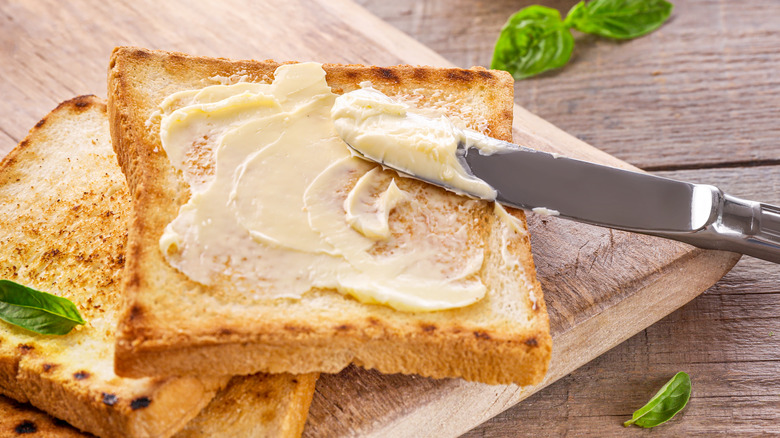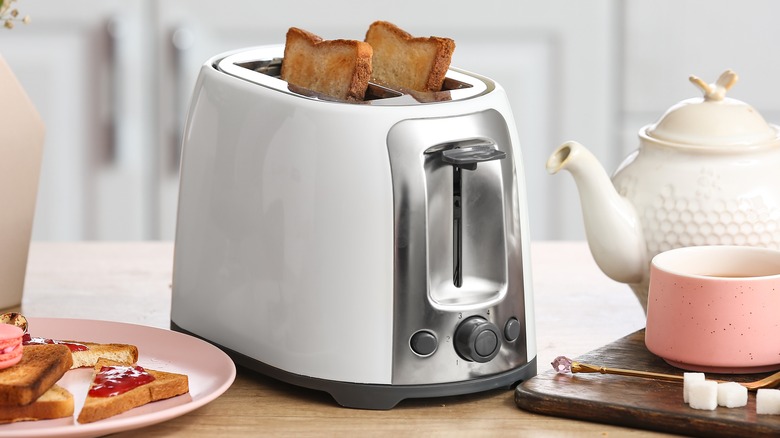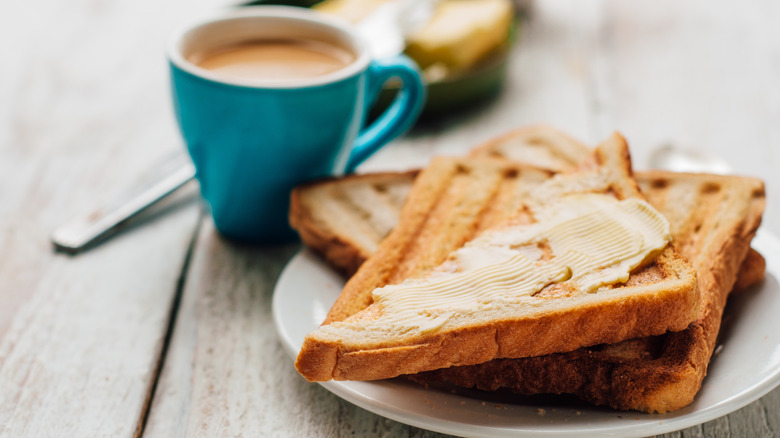There Is A Perfect Number Of Seconds To Toast Bread, Actually
How do you toast bread? Easy, you might say, you use the toaster. How much time your toaster actually takes to toast bread varies from toaster to toaster, but it's usually a simple process all-around. Of course, when you're making toast, you have to be very precise with time. Every second of your bread sitting inside the toaster can make or break your breakfast. If you leave your toast in for too short an amount of time, the bread's still chewy and lukewarm. If you leave it in your toaster for too long, the toast will obviously burn.
It would make sense, then, that there exists a perfect window of time, a "sweet spot" where your bread is perfectly toasted front and back and doesn't taste charred or under-cooked. There is, some argue, an exact amount of seconds in which bread can become fully toasted — and that number is 216 seconds. 216 seconds (or around 3.6 minutes) may sound like a random guess at first, but there's actually a bit of scientific data to support such a claim. What exactly is this data, and what makes 216 seconds the perfect amount of time you need to make your morning toast?
216 seconds is part of a mathematical formula
The pursuit of science doesn't stop at the breakfast table, as scientists performed an in-depth experiment to reveal the perfect amount of time needed to toast bread. In 2011, food scientist Dr. Dom Lane and his team set out to discover if there was a formula that could give someone the perfect piece of toast. Going through an incredible 2,000 slices of bread in one week, the team experimented with different times and temperatures until finally settling on the time of 216 seconds at a temperature setting of "five out of six" on an average toaster dial.
If the bread has been toasted for this exact time and at this exact temperature, the end result should be a piece of toast that's golden, soft on the inside, and has an exterior that is twelve times crunchier than the middle. It's a piece of toast that is not too crunchy, not too soft, and has just the right color to it — in short, it's something that could very well fit the definition of a "perfect" piece of toast. But what other components make up this breakfast-time mathematical formula? Temperature and time aren't the only factors to consider when making your morning piece of toast.
The thickness of the bread also plays a key factor
The thicker something is, the longer it takes to cook through, while something that is thinner cooks faster. Finding the correct thickness plays an important part in making the perfect piece of toast, even if you may not know it. According to Dr. Lane's experiment, the ideal thickness of the bread you're going to be toasting with should be 14 millimeters or 0.551181 inches. If you can't get your bread to be this exact thickness, you should at least aim for near it. This thickness, or perhaps, in this case, thinness, helps to ensure the bread cooks evenly and quickly without burning too fast or remaining under-cooked as it pops out of the toaster. It's thick enough to hold its shape and not crumble apart, but thin enough to eat without having to cut.
Once the toast is done, you'll probably want to butter it up. As Reader's Digest tells us, the best amount of butter you should spread across your 14mm thick piece of toasty perfection is 0.44 grams of butter per square inch. This claim is courtesy of food scientist Dr. Bronek Wedzicha, who notes the amount of butter "should be one-seventeenth this thickness of the bread." Nothing gets the brain jogging in the morning like calculating measurements!


